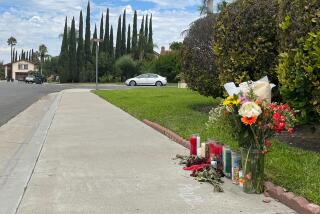UCI Plans Largest Breast Cancer Study in U.S. : Health: Researchers, backed by a $2.3-million grant, will track affected women in Orange County, which has the highest incidence of the disease in the country.
IRVINE â UC Irvine researchers, armed with a new $2.3-million grant, will meet today to plot a study of breast cancer genetics in Orange County, which has the highest rate of that cancer in the nation.
*
The grant from the National Cancer Institute will fund a four-year study that will attempt to isolate the gene for breast cancer by studying its occurrence in families. Then scientists can attempt to discover what roles the gene and the environment play.
Researchers already know that environmental factors play a role but are not certain what effect the gene has, said Hoda Anton-Culver, director of epidemiology at UC Irvine.
Four faculty members at UC Irvineâs Epidemiology Center will work with scientists at Utah and other California universities to track most Orange, San Diego and Imperial county women diagnosed with breast cancer in the last 10 years, as well as those who are diagnosed with it in the next four years, Anton-Culver said. It is the largest study of breast cancer in the nation.
With its large Vietnamese and Latina population, Orange County âis an important and interesting locationâ for the study, Anton-Culver said.
The county leads both the country and the state in breast cancer occurrence, so the pool of study participants should prove invaluable to the research, she said.
Today the team of researchers will begin a two-day conference at UC Irvine at which final decisions will be made on the execution of study procedures, including the questionnaires and tracking techniques. Anton-Culver expects about 80% of eligible women to volunteer to be in the study.
âWeâd like to determine what factors cause one person who has the gene to get breast cancer and another person (who has the gene) to live to 80 years with no cancer whatsoever,â said Pamela R. Fain of the University of Utah, a member of the research team.
Duncan Thomas of USC, also on the team, said: âA key element in this study is to look at environmental factors and genetic factors in combination, something that has seldom been done before. It could well be that the gene for breast cancer acts by creating a sensitivity to factors such as hormones, electromagnetic fields, diet and pesticides,â which are often triggers for the disease.
By investigating the geneâs frequency in the population, researchers hope to prevent people at high risk in the study area from contracting the disease. Ultimately, âthe information will be applied to the whole (country),â Anton-Culver said.
Researching Cancer
Between 1988 and 1992, breast cancer killed 1,600 women in Orange County. The number has varied widely from year to year:
*1988: 324 1989: 342 1990: 299 1991: 345 1992: 297
*Age, Ethnicity Factors As in previous years, breast cancer killed mostly white and older women in 1992. *Ethnicity Whites: 92% Latinas: 5% Asians: 2% Blacks: 1% *Age 65 and older: 57% 50-64: 28% 35-49: 14% 34 and younger: 1% *Breast Cancer Facts - Each year, 1,200 Orange County women are diagnosed with breast cancer. - About 25% of county women older than 60 have never had a mammogram, which could lead to early detection. - 92% of breast cancer cases can be cured if detected early. - Breast cancer tends to afflict white women who have a high-fat, low-fiber diet and have children later in life or not at all. - In 1992, the county mortality rate from breast cancer was 11.7 per 100,000, one of the highest rates in California. *Sources: Orange County Health Care Agency, UC Irvine, California Department of Health Services, California Cancer Registry, American Cancer Society; Researched by CAROLINE LEMKE and ELAINE TASSY / Los Angeles Times






